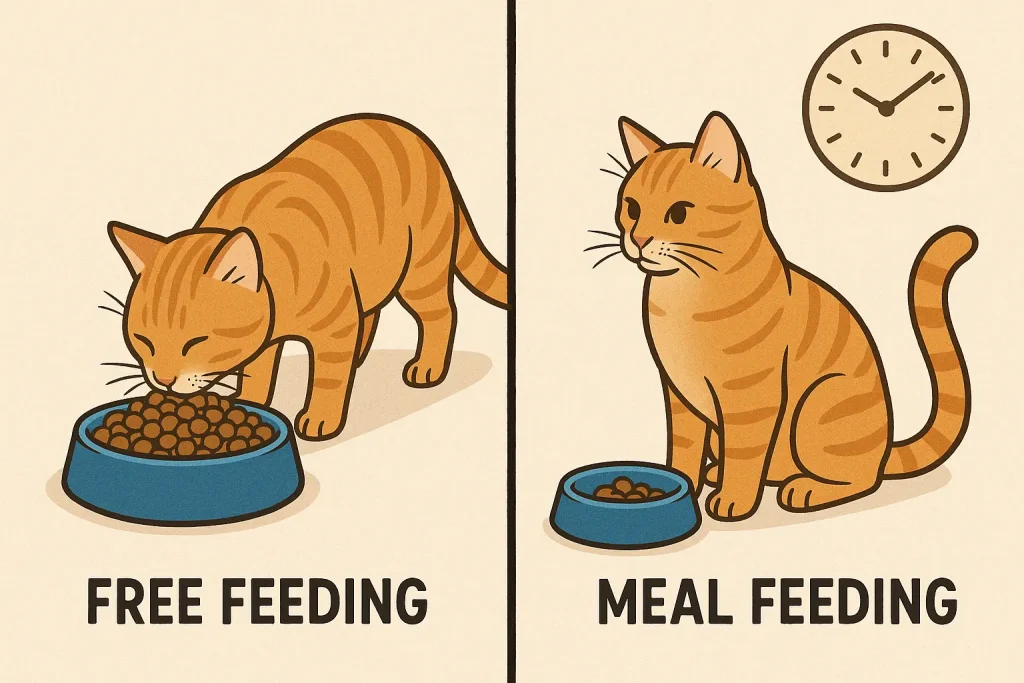
Introduction
Are you trying to figure out how to transition cat feeding from free to meals effectively? You’re not alone. Many pet owners begin with free feeding because it seems simple—just fill the bowl and your cat eats when they want. But over time, this approach can lead to unintended health issues like obesity, unpredictable eating habits, and difficulty tracking your cat’s intake.
Learning how to transition cat feeding from free to meals effectively helps you take back control of your cat’s health. By switching to a structured meal schedule, you can manage portion sizes, observe appetite changes, and create a daily routine that supports both physical health and behavioral well-being.
In this guide, we’ll walk you through a clear, step-by-step process to help your cat adjust smoothly to scheduled meal times—so they stay happy, healthy, and well-fed on your terms.
Understanding Free Feeding and Meal Feeding

What is Free Feeding?
Free feeding involves leaving food out all day, allowing your cat to eat whenever they choose. This method is typically used with dry kibble, which doesn’t spoil quickly.
What is Meal Feeding?
Meal feeding means providing food at specific times during the day. You offer a measured portion, let your cat eat, and then remove the bowl after a set time.
Pros and Cons
| Feeding Method | Pros | Cons |
| Free Feeding | Convenient; always available | Difficult to monitor intake; risk of overeating |
| Meal Feeding | Controlled portions; easier to monitor | Requires scheduling and consistency |
Benefits of a Structured Cat Feeding Routine
Establishing a routine when feeding your cat means more than convenience, it’s a great way to promote your cat’s physical and emotional wellbeing. Cats are creatures of habit. Feeding them at set times during the day creates the routine of eating at a time they can depend on. This level of consistency can lower anxiety, limit food aggression, and even help determine their litter box habits by regulating their digestion.
By establishing a meal routine for your cat, it will also help you identify health issues. If your cat does not eat, this is an important cue that something may be wrong. This is especially useful when the cat is fed on a free feeding basis. In addition to meal timing and content, you will know exactly how much food was consumed at all times, which is handy when determining weight management like food portions.
In summary, setting a structured feeding routine for your cat is one of the easiest things to do that can have both a pronounced effect on your pet’s quality of life and your relationship.
Why Transition to Meal Feeding?
Transitioning to meal feeding offers several benefits:
- Weight Management: Helps prevent obesity by controlling portion sizes.
- Health Monitoring: Easier to notice changes in appetite, which can indicate health issues.
- Routine Establishment: Cats thrive on routine, and scheduled meals provide structure.
- Behavioral Benefits: Reduces begging and food-related anxiety.
How to Transition a Cat from Free Feeding to Meals
Establish a Feeding Schedule
Choose meal times that fit your schedule, usually two to three times a day. As it is for other animals, consistency will help your cat adjust.
Measure Total Allowance
Measure out the total amount your cat requires each day and divide it by the amount of meals you have chosen. Use a measuring cup to be exact.
Gradually Eliminate Free Access
Start eliminating access to the food bowl for periods of time throughout the day. Gradually increase these periods until your cat is accustomed to eating only at their meal times.
Make Mealtimes Exciting
Ramp up their interest with high-quality, palatable food. With canned food, you can even warm it slightly to release the aroma.
Use Positive Reinforcement
Give your cat verbal praise during their meal; while it is eating affection will help to build positive associations with scheduled feeding.
Be Patient and Consistent
Some cats will be resistant to the change, and your new schedule will not look ideal first. Try to remain consistent with feeding their meals at the same time, and do not give into begging between meals.
Tips for a Smooth Transition
Interactive Feeders to Simulate Natural Behavior
Use puzzle or interactive feeders for designated mealtimes. These devices can make eating feel like a fun challenge and tap into your cat’s natural hunting instincts. They help slow down fast eaters, and they can make the change to a feeing more stimulating and engaging — especially if your cat is use to “snacking” throughout the day.
Establish Separate Feeding Zones in Multi-Cat Homes
If you have multiple cats, you should feed them in separate, quiet places so they can eat without competing or guarding food. This provides a low-stress way for them to eat and is a good way to control how to transition cat feeding from free feeding to feeding meals effectively for each pet.
Consult Your Veterinarian for Personalized Guidance
If your cat is overweight, has specific dietary needs in the transition, or is not transitioning well, we recommend seeking veterinary guidance. A veterinarian can help you determine how much and what to feed, as well as suggest a feeding schedule based on your cat’s age, weight, and health issues to make the transition safer and more effective.
Common Challenges and Solutions
Begging Between Meals
During this transition, perhaps the most common problem is consistent begging. The cat may meow, paw at the food bowl, or follow you around hoping for snacks. Whatever the method, the goal is to get you to give in. The easiest solution is to distract with some play or attention. Quick play sessions can help to redirect attention and alleviate boredom, both important aspects of helping your cat adjust to how you are transitioning feeding from free to meal feeding properly.
Refusal to Eat Scheduled Meals
If your cat is not eating at the scheduled mealtimes, there is no reason to panic. First, make sure the food is fresh and smells delicious. It’s even possible to slightly warm wet food, or you could use a small amount of a great tasting topper. If they still refuse to eat for more than 24 hours, consider calling your veterinarian to discuss the situation, rule out potential health-related issues, and obtain professional advice on how to progressively switch over from free feeding to scheduled meals (and also how to do this in a way that won’t risk your pet’s health).
Overeating or Gulping at Mealtimes
Cats that are used to grazing might overeat or gulp food if food is limited to mealtime/social time. Vomiting or discomfort may occur. To help with this, please consider using a slow-feed bowl or food puzzles to make your cat eat more slowly and to promote a healthier way of eating. Using slow-feed bowls or puzzles will enable your efforts to manage cat feeding from free to meal feedings effectively through more mindful, controlled feeding.
Frequently Asked Questions
Q1: How long does it take to transition a cat to meal feeding?
A1: It varies, but most cats adjust within one to two weeks with consistent scheduling.
Q2: Can I still give my cat treats?
A2: Yes, but limit treats to no more than 10% of daily caloric intake and offer them at specific times.
Q3: What if I have multiple cats with different dietary needs?
A3: Feed them separately and consider using microchip-activated feeders to ensure each cat gets the appropriate food.
Q4: Is meal feeding suitable for kittens?
A4: Yes, kittens benefit from multiple small meals a day to support their growth and energy needs.
Q5: How do I handle feeding when I’m not home?
A5: Use automatic feeders to dispense meals at scheduled times in your absence. Visit DierLuxe.shop
Q6: Will meal feeding help with my cat’s weight loss?
A6: Yes, controlling portions and meal times can aid in weight management. Consult your vet for a comprehensive plan.
Conclusion
Transitioning cat feeding from free to meals effectively is one of the most impactful changes you can make for your cat’s long-term health and well-being. By shifting away from constant food access and toward structured mealtimes, you can manage weight, encourage better digestion, and create a predictable routine that your cat can rely on.
Stick to a consistent feeding schedule, choose high-quality, appetizing food, and use positive reinforcement to ease the transition. Monitor your cat’s behavior and eating habits closely during the process. If challenges arise—like refusal to eat or digestive issues—don’t hesitate to consult your veterinarian for personalized advice.
With patience and persistence, your cat will not only adjust but thrive under this new, healthier feeding routine. Now that you know how to transition cat feeding from free to meals effectively, you’re on the right path to raising a happier, healthier feline companion.


